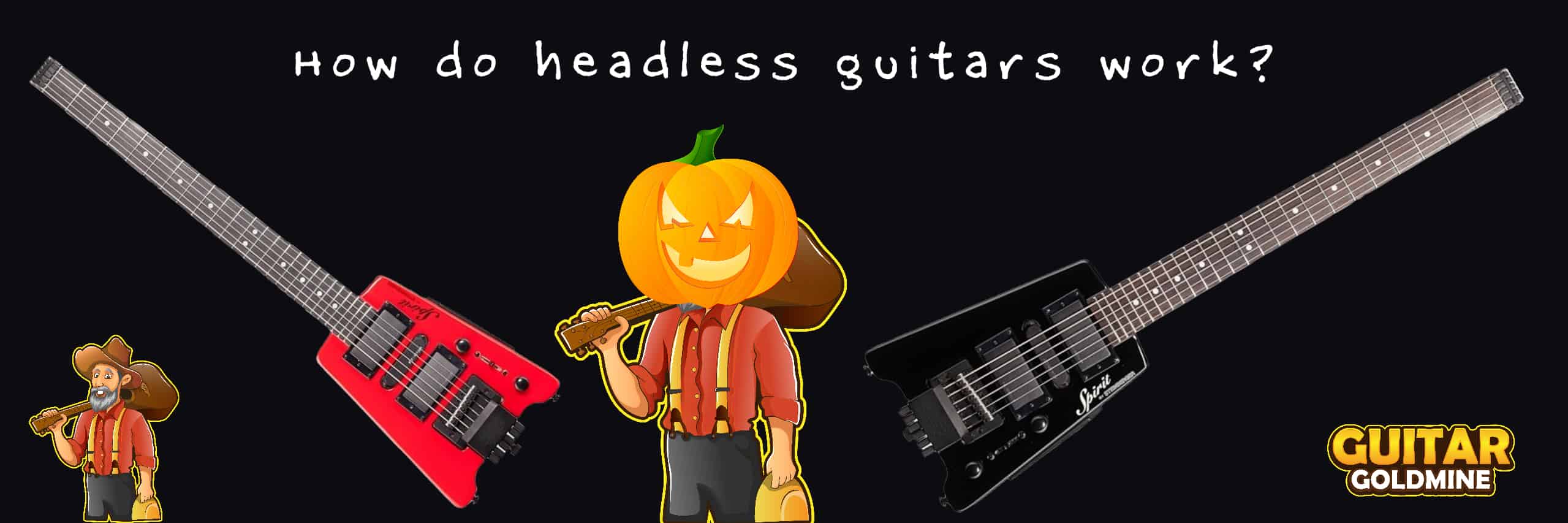 A headless guitar has a bit of a confusing appearance, but it’s a guitar nonetheless. There’s a whole world of guitar types, shapes, and sizes out there, from the basics of both hollow body and solid body to the innovative and sometimes strange varieties of multi-necked and headless guitars. But how does a guitar function without the head holding the tuning keys?
A headless guitar has a bit of a confusing appearance, but it’s a guitar nonetheless. There’s a whole world of guitar types, shapes, and sizes out there, from the basics of both hollow body and solid body to the innovative and sometimes strange varieties of multi-necked and headless guitars. But how does a guitar function without the head holding the tuning keys?
Headless guitars work by removing the head where the tuning keys usually are and, instead of placing them at the bottom, anchoring the guitar strings just above the neck and fretboard. This helps prevent the guitar from neck warping and makes stringing and restringing the guitar simpler while providing other advantages as well.
Unless you’re already familiar with headless guitars, coming across one probably filled your head with all kinds of questions… is that a real guitar? Does it sound the same as other guitars? Is that guitar better than others? But don’t worry. We’ve got the answers right here. Just keep reading.
How Headless Guitars Work
Headless guitars were first seen in the 70s and 80s during the rise of the electric guitar’s popularity. Achieving the right sound on a guitar means having the correct tension on the strings, and before, this had always been done by turning the tuning keys on the head of the guitar. But how would that work on a guitar with no head at all?
The solution was to move the ability to tune down to the opposite end of the guitar, basically switching where the strings were anchored and where they were tightened. This design-led to some interesting benefits; namely, it made stringing the guitar easier while also equalizing tension along the body of the instrument.
Instead of the traditional “head,” the headless guitar will have a short area where the strings are anchored instead. Most headless guitars have solid bodies and are electric. Unlike the usual shape of a solid body guitar, there will be a cut out along the bottom where the tuning apparatus is placed.
Because tension along the guitar’s body was more equal, the neck warping of these guitars is much rarer. Additionally, the ease of restringing this type of guitar makes it a great choice for people looking for a more ergonomic instrument. Headless guitars are also generally lighter.
Sound is slightly different on headless guitars because instead of beginning the fretboard with the “nut,” they instead have what’s called a zero fret. This causes the tone of the guitar to be more uniform. Uniformity of tone means that the notes the guitar produces will sound more similar to each other-except for pitch, similar to a piano.
Headless guitars are also more balanced when it comes to weight, which is another reason why people consider them more ergonomic and less cumbersome to use.
Playing a regular guitar will often cause tension in your upper body, especially in your upper back, shoulders, and neck. The structure of a headless guitar allows it to create a similar sound with less tension on the player’s body.
Headless Guitars vs. “Traditional” Guitars
Headless guitars have the advantage of being more ergonomic, lighter, more uniform in their tone, and easier to string. Guitars with heads are more widely available and have more variety of shapes and body types as well.
A headless guitar is great for longtime players who may have lost some mobility over the years, as well as people who want to learn the guitar who may have any number of physical issues. This type of guitar makes playing more accessible to anyone who might not be able to use an old-fashioned guitar.
A more traditional guitar- one with a head, that is- will probably get fewer odd looks when you pull it out, but that’s not really a reason to pick one or the other. But when picking an instrument, many people will take aesthetics into account, and you may feel like you won’t look the part of the guitar player in your head with a headless guitar.
If you’re self-teaching the guitar, learning on a traditional guitar may make it easier for you to use online videos or classes since most will be held on the older variety, and fewer headless guitar-specific classes might exist.
Classically shaped guitars may experience neck warping due to the tension placed on them from the stings, and this is much less likely on headless guitars because the tension is more evenly spread out over the body and neck of the guitar.
Most headless guitars are electric, and their shape is close to the classic solid body electric guitar we know and love. You may find less variety in headless guitars than other types or need to go to a specialty shop in person or online to find one.
There are several huge advantages to choosing headless guitars, and there’s a reason many people have decided to make the switch. Some people will stick with their old-style guitars until the day they die, and some will jump between them for every song.
Is One Better? How do I Choose?
This is always an interesting question to answer when it comes to instruments because the answer is almost always “it depends.” This one is no exception. Any instrument is going to suit different people in different ways.
Some people have used guitars with heads for so long they can’t imagine using anything else. Other people will pick up a headless guitar and never look back. If you love playing guitar but find things like restringing and the usual method of holding the guitar difficult or painful, a headless guitar might be exactly what you need.
There really is no wrong answer to the question of which type of guitar to choose. I would recommend trying both before deciding between them. But there’s also no reason you can’t play both types- if there’s a law out there against owning multiple guitars, I’ve never heard of it!
Headless guitars might be better for people with certain disabilities or who just enjoy less strain on their body from playing music. Picking a musical instrument is a completely unique process for each individual.
Before choosing either type of guitar, there are several good questions to ask yourself, such as:
- Can I play comfortably on this guitar?
- Do I like how this instrument looks and how I look playing it?
- Can I learn how to use this instrument properly if I haven’t had a guitar like this before?
- Can this guitar do everything I want it to?
- Have I tried all the types of guitars I might want to play?
Don’t forget: it’s okay to change your mind later. Choosing between a headless and traditional guitar is not a lifelong commitment, and despite all the differences between their looks, they are the same instrument. If you can play one, you can play the other.
Final Thoughts
Headless guitars have been around since the 1970s, and they don’t seem to be going anywhere. Why would they, when there are some serious advantages to playing them? Some people may still be turned off on the idea of playing a guitar without a head, but plenty of people have added them to their collection or switched over completely.
Whether you’re an old hand at playing guitar or someone looking to dive in, headless guitars are a fun choice that will work well for a lot of people. They’re definitely worth a try before dismissing these headless wonders.

Recent Comments